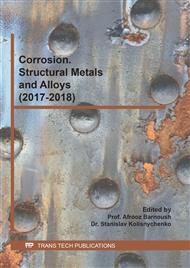p.1
p.10
p.18
p.26
p.33
p.38
p.45
p.52
Experimental Investigation of Parameters and its Effect on IGC Attack in Ferritic Stainless Steel 430 Weldments
Abstract:
Corrosion is a natural occurring phenomenon which exists as a part of our everyday life. Generally stainless steel is having good corrosion resistance which undergo some specific type of corrosion. Corrosion problem in stainless steel has a huge economic and environmental impact on virtually all facts of world’s infrastructure, from highways, bridges, and buildings to oil and gas, chemical processing, and finally it play an ever increasing role in the largest industry in the world is food industry and automotive industry. The corrosion problem is quite costly and it has no easy solution so large amount of money is utilized to analyse the corrosion damage and also to replace the corroded components. The focus of this paper is to investigate the intergranular corrosion studies of industrially important stainless steel of AISI 430 by two different corrosive solutions were 40% Nitric acid (ASTM-A262-Practice C) and copper – copper sulphate 50% Sulphuric acid (ASTM-A262-Practice E) of Gas tungsten Arc welded Metal which were weighted and immersed in test solutions. After immersion, these weldments were removed, washed, and then weighted to determine the weight loss. The analysis of experimental data obtained on intergranular corrosion and the micrographs by Scanning Electron microscope were carefully analysed, monitored, and revealed to study the behaviour of intergranular corrosion of AISI 430, Stainless steel weldments.
Info:
Periodical:
Pages:
10-17
Citation:
Online since:
October 2016
Authors:
Keywords:
Price:
Сopyright:
© 2017 Trans Tech Publications Ltd. All Rights Reserved
Share:
Citation:



